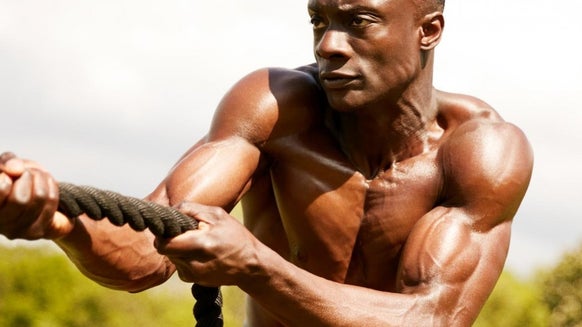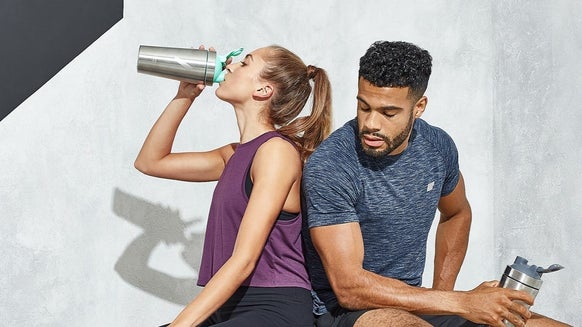A Beginner’s Guide to Boxing Training
Muhammad Ali once said, "If my mind can conceive it and my heart can believe it, then I can achieve it." As boxing's greatest ever, he knew better than anyone else the power of the mind when it comes to succeeding in the ring.
Boxing is a sport that requires mental toughness. Pros must rely on more than just technical skill, physical strength, and tactical awareness to get them through 12 rounds. They also need bravery, self-belief, motivation, discipline, and focus if they want to win.
What is boxing?
Boxing is a sport that works out the full body, with footwork and feinting as well as punching. Other workouts, like jumping rope and calisthenics, are also often incorporated into boxing training to increase the intensity of the session.
There are two forms of boxing: amateur and professional. All boxing fights take place in a square ring and involve two fighters matched according to weight class. All boxers must wear padded boxing gloves, and amateur fighters must also wear protective headgear.
A boxer wins the fight either by knocking out or winning more points than the opponent. Judges sitting outside the ring keep score throughout the fight, and a referee supervises to ensure fighters abide by the rules and end the fight if it's becoming unsafe.
Amateur bouts usually consist of three three-minute rounds with a one-minute interval between each, and pro fights can go up to 12 rounds.
Benefits of Boxing Training
Fitness & Heart Health
Boxing is a high-intensity sport that has been associated with good heart health. One study found that high-intensity exercise can be beneficial for heart health, and another small study found that boxers' rankings had moderate to strong correlation with their aerobic capacity.1,2
Weight Loss & Improved Strength
Boxing is a full-body workout that burns lots of calories and helps build muscle. You need to use your entire body to throw a punch, including the lower limbs and core muscles, so boxing can help make you stronger while aiding weight loss.
Improves Balance & Coordination
By focusing on proper movement and technique, boxing can improve balance and coordination. Beginners should incorporate boxing balance drills early on in their training to establish a sense of balance for fighting.
Reduced Stress & Better Quality of Life
One study found that boxing training was not just better for cardiovascular health than an equivalent dose of brisk walking, but it was also better for health-related quality of life outcomes.3
Additionally, boxing can also have many mental benefits, like increased confidence, concentration, resilience, and self-belief.

Basics of Boxing
Basic Boxing Gear
The kind of boxing equipment you'll need depends on whether you'll be training with or without a partner. It's likely you'll eventually do both.
If you're training boxing basics without a partner, you will need: a heavy bag, skipping rope, hand wraps, and bag gloves.
When training with a partner, you'll need: headgear, a mouthguard, sparring gloves, and a groin or chest protector.
Boxing Stance
Start by standing with your feet shoulder-width apart.
If you're right-handed, take one step back with your right foot. Left-handers, do the opposite. The lead toe should be in line with the rear heel.
Turn your lead shoulder towards your opponent or bag. Bend your knees slightly.
This staggered stance helps you maintain balance and allows you to use your hips for power when throwing a punch. In a real match, it also makes you a smaller target for your opponent, giving them less area to connect a hit.
Keep your elbows down and hands up. Keep your head behind your gloves, with your chin slightly down and your eyes looking over the gloves.
Boxing Footwork
Beginners in boxing need to master the step-drag and pivot manoeuvres. In boxing, it's important to keep your feet on the ground so that you’re always ready to attack, defend, or move away. Don’t waste energy jumping around. With practice, flashy footwork will come naturally once you develop better conditioning and technique.
Step with the lead foot and drag the rear foot. This stepping and dragging boxing footwork technique ensures your weight is grounded and always ready to attack or defend. It also prevents you from walking or crossing your feet, which can make you fall off balance. To go forwards or left, step with your left foot first and then drag the right foot after. - To go backwards or right, step with your right foot first and then drag the left foot after.
Try to finish all steps with your feet at the same distance.
The pivot is the second-most important footwork technique. It’s usually done by pivoting off your front foot. You can use it defensively to avoid attacks or offensively to find new punching angles. A pivot can be useful for counter-punching by taking you out of harm’s way and keeping you in range to throw counter punches.
- Pivot clockwise by swinging your right foot and letting your body pivot over the left foot.
Practise small pivots (45-90 degrees) as well as big pivots (90-180 degrees).
Boxing Punches
Basic Punching Technique:
Start in a relaxed stance Exhale sharply as you throw the punch Tighten your fist and engage your core muscles Release your hand back to the starting position
Punching is not just about arm strength, but also utilising the power of your entire body to deliver a more powerful blow. Keep your body weight evenly distributed throughout the punch to avoid losing balance.
Boxing Breath
This breath work helps with both timing and power.
- Inhale to prepare for a punch.
- As you throw, exhale fast through your mouth (versus your nose) with a closed jaw. This should sound like a hiss.
- In a real match, you could risk breaking the jaw if your mouth is open and you take a hit to the chin.
The purpose of this sharp exhale is to engage the core and connect the punch to your body.
Take Home Message
Boxing is a great way to get in shape, build strength, and boost your heart health. Plus, it's a fun and safe way to relieve stress that also has the added bonus of developing mental strength like confidence, self-belief, and discipline.
Whether you're aiming to become a pro boxer or just want to get a little bit fitter, boxing training can benefit pretty much anyone. Not only will you see physical improvements, but the mindset shift that comes with learning a new skill could give your confidence a boost.
Got some more time?
READ THESE NEXT:








